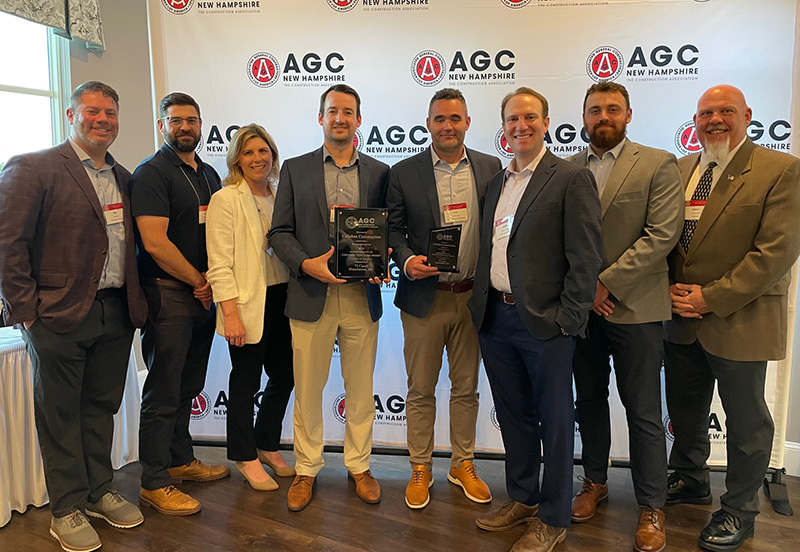NEREJ holds Healthcare Facility Summit in conjunction with MED|Ed Facilities
Boston, MA With an aging Baby Boomer population requiring more medical services from providers and rapid technological changes affecting the way that medical care is delivered, health care systems have had to develop new strategies to effectively manage their facilities and real estate. Last month, the New England Real Estate Journal presented the Healthcare Facility Summit (in conjunction with MED|Ed Facilities), to help industry professionals better understand how hospitals and healthcare systems are adapting to those changes. Held at the Boston Seaport Hotel, three separate panels examined how the investment sales market for medical facilities is faring; the changing physical plant for medical facilities; and the design trends and product developments that are improving both the patient and workplace experiences.
 Shown (from left) are: Mary Jo Olenick, principal at The S/L/A/M Collaborative; J.P. Bonin, senior consultant at the Sextant Group; Martha Boyd, senior project manager for capital planning and construction at UMass Memorial Medical Center; Jake Horak, senior manager of Healthcare Strategy Practice; and moderated by David Neal, principal at The S/L/A/M Collaborative.
Shown (from left) are: Mary Jo Olenick, principal at The S/L/A/M Collaborative; J.P. Bonin, senior consultant at the Sextant Group; Martha Boyd, senior project manager for capital planning and construction at UMass Memorial Medical Center; Jake Horak, senior manager of Healthcare Strategy Practice; and moderated by David Neal, principal at The S/L/A/M Collaborative.In the opening session, commercial real estate writer Mike Hoban of Hoban Communications discussed capital market trends and financing with Daniel Turley, senior vice president for healthcare in the Capital Markets Group of JLL, and Keith Wentzel, managing director at Fantini & Gorga. The panelists affirmed that the demand from private investors for medical office facilities remains strong, but “there’s not a huge amount of supply being developed in New England right now, and (what is available) is still controlled by the major healthcare institutions” said Wentzel. Facilities that are most attractive to investors are ones that have a solid base of good credit tenants, which generally means that a major hospital or aligned physician groups that are affiliated with the hospitals are taking significant space at the property.
There is plenty of financing available for medical office, said Wentzel, but the type of financing depends largely on the cap rates for any given property. “The lower the cap rate, the higher quality the product it is, so the life companies are going (to be attracted to those deals). With the higher cap rates, it’s usually a property that is not as much in demand from a buy and sell standpoint, so the financing will probably be a little bit more challenging.”
Despite the robust demand for medical office product, the proliferation of hospital mergers is having a cooling effect on the investment sales market. “You’re seeing two different phenomena – obviously the demand is increasing but you’re also seeing a larger consolidation within the healthcare arena,” said Turley. There are currently about 3,000 healthcare systems and hospitals throughout the country, he explained, and with the major consolidations now occurring, that number will soon dwindle to approximately 1,000 healthcare systems. “For the investor groups and developers that we (JLL medical practice group) represent, they’re trying to align themselves with the winners, and Boston just so happens to have a ton of winners who don’t need outside investors cash,” said Turley. “So it’s very tough to find medical office facilities within the Boston area that hospitals or health systems are letting go of.”
 Shown (from left) are: Daniel Turley, senior vice president for healthcare in the capital markets group of JLL; commercial real estate writer Mike Hoban of Hoban Communications; and Keith Wentzel, managing director at Fantini & Gorga.
Shown (from left) are: Daniel Turley, senior vice president for healthcare in the capital markets group of JLL; commercial real estate writer Mike Hoban of Hoban Communications; and Keith Wentzel, managing director at Fantini & Gorga.The second panel of the day focused on how changes in healthcare delivery are affecting the way that facilities are being built and renovated, particularly in academic medical facilities (AMCs). Moderated by David Neal, principal at Glastonbury, CT-based The S/L/A/M Collaborative, the panel included Jake Horak, senior manager of healthcare strategy practice at Kurt Salmon; Martha Boyd, senior project manager for capital planning and construction at UMass Memorial Medical Center; J.P. Bonin, senior consultant at the Sextant Group; and Mary Jo Olenick, principal at The S/L/A/M Collaborative.
One of the major changes in healthcare delivery is that more patients are being treated in clinical settings rather than on an inpatient basis. “A lot of AMCs are starting to recognize that over half of their revenue is coming from ambulatory care, as well as half of their margin,” said Horak. “Historically, most of their planning efforts and capital spending has been on the inpatient side – close to 90% of it. Now they’re recognizing the need to shift their thinking and start to invest more in ambulatory.”
Another emerging trend is universal design in both ambulatory and inpatient rooms. No longer are they building rooms for one specialty, because it is uncertain what the mix of healthcare services are going to look like in the future. “All of our construction for inpatient rooms are for private rooms, but they are very flexible rooms,” said Umass’ Boyd. “We’re not building an orthopedic room or (another specialty) we’re building a room that you can use at any given time for any type of patient.”
 Shown (from left) are: Lilliana Alvarado, design principal at UPHEALING; Michelle Bridge, business development manager for Capital Carpet and Flooring; Mark Weiner, architectural account executive for Sherwin Williams; and moderated by Sharon MacDonald, CEO of Model55.
Shown (from left) are: Lilliana Alvarado, design principal at UPHEALING; Michelle Bridge, business development manager for Capital Carpet and Flooring; Mark Weiner, architectural account executive for Sherwin Williams; and moderated by Sharon MacDonald, CEO of Model55.The final panel of the day addressed the changes in facilities design and new products available to improve the hospital environment for patients and staff. Moderated by Sharon MacDonald, CEO of Model55, a design firm specializing in custom design services for the 55+ senior living industry as well as multifamily, the panel included Mark Weiner, architectural account executive for Sherwin Williams; Lilliana Alvarado, design principal at UPHEALING; and Michelle Bridge, business development manager for Capital Carpet and Flooring.
On the product front, Weiner stressed that with interior design for medical facilities, “it’s not about the materials, you’ve got to think about the person walking into the facility, the patients (and staff).” In response to medical facilities high infection rates, Sherman Williams has devised a new product, Paint Shield, an EPA-registered paint that kills greater than 99.9% of staph, MRSA, E. Coli and VRE within two hours of exposure on a painted surface.
Alvarado emphasized the importance of collaborative decision making in the design process, and to always consider the functionality of design over aesthetic qualities in medical facilities. “The aesthetics (need to be considered), because if it’s pretty but could break someone’s back, it’s useless.”
Nobis Group awards Robinson and Moreira STEM scholarships


The rise of incubators and co-working spaces: The latest in life sciences - by Matt Combs

Ask the Electrician: Is summer a prime time for commercial electrical maintenance?

Careers in Construction Month focus on training and safety - by Joe Camilo








.png)